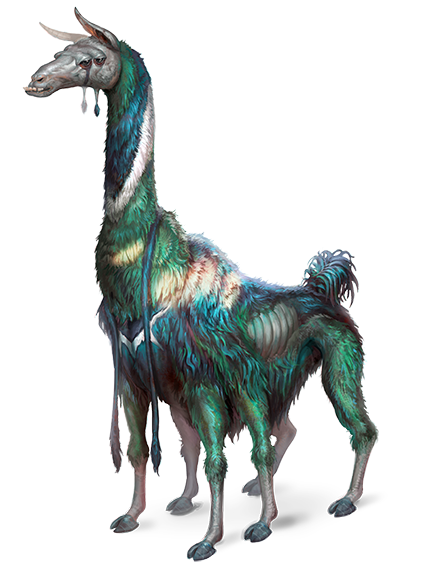Herd AnimalSource Alien Archive 2 pg. 75
From the ruthigs of Castrovel to the wollipeds of Triaxus, herd animals are beasts that gather in social groups comprised entirely of creatures of the same species. Herding behavior allows animals to gather and move together for protection from predators. Most commonly, herd animals are herbivores or docile omnivores. Predator statistics better represent fiercer animals, including aggressive herbivores and omnivores that may or may not move in groups of their own kind.
In the Pact Worlds, the most common herd animals are domesticated. When various species took to exploring and colonizing the stars, they brought their livestock with them. For instance, cattle, goats, and sheep can be found on Absalom Station, as well as on any world where humans have a significant presence. Herd animals in the Pact Worlds serve a variety of purposes in the various societies that cultivate and support them. Farmers and engineers commonly maintain groups of herd animals to harvest their meat, though keeping herd animals for their shorn fur to create textiles is a more sustainable practice. Other cultivators leverage herd animals as mounts or pack animals, and training these docile creatures can result in large profits for professionals who are particularly skilled in this pursuit.
More rarely, some xenobiologists even cultivate groups of herd animals for scientists and corporations who wish to stabilize wild planets’ ecosystems. In this case, interested parties might place large numbers of pack animals in foreign locales to help tame rampant vegetation growth or provide prey for a dying species of predator. The goal of such projects is almost always to improve a planet’s suitability for colonization, mining, or farming. However, this practice is often controversial among ethnobiologists, who argue that introducing large populations of non-native species in this manner produces harmful and unforeseen results more often than it aids environments. Creating Herd Animals The herd animals in this entry serve a couple of purposes. Employ them as written when you need statistics for this sort of creature. To create a unique herd animal, use the stat blocks here and your concept as starting points. Decide what type of natural weapon the animal has, from antlers to hooves, altering the damage type to suit the weapon. Then add elements from Appendix 2: Environmental Grafts (see page 138). Tailor anything you want to fit your concept. Sample Herd Animal The ruthig is a mammal with six legs, padded feet with toenails, a long and thin neck, an extended jaw with flat teeth, a lengthy and rough tongue, and two pairs of eyes. Its shaggy fur is home to a plethora of algae and moss species, giving the ruthig a mottled green color useful as camouflage in the herbivore’s native woodlands. Wild ruthigs travel in grazing herds, which are less camouflaged during the birthing season when gray-furred young are born. People of Castrovel domesticate the beasts for their honey-sweet milk and succulent meat.
A ruthig is a Medium herd animal that is about 4 feet tall at the withers and 6 feet tall with its head raised high. On average, a ruthig weighs about 250 pounds. A ruthig can use its bludgeoning kick as a natural weapon, and it has camouflage when in forested terrain.Aliens in the "Herd Animal" FamilySource Alien Archive 2 pg. 74Gargantuan Herd Animal CR 6 XP 2,400 XP 2,400
N Gargantuan animal
Init +0; Senses low-light vision; Perception +13
DefenseHP 90
EAC 18; KAC 20
Fort +11; Ref +8; Will +6
OffenseSpeed 30 ft.
Melee natural weapon +15 (2d4+12 B)
Space 20 ft.; Reach 20 ft.StatisticsSTR +6; DEX +0; CON +4; INT -4; WIS +1; CHA -2
Skills Athletics +18EcologyEnvironment any
Organization solitary, pair, or herd (3–12)
|